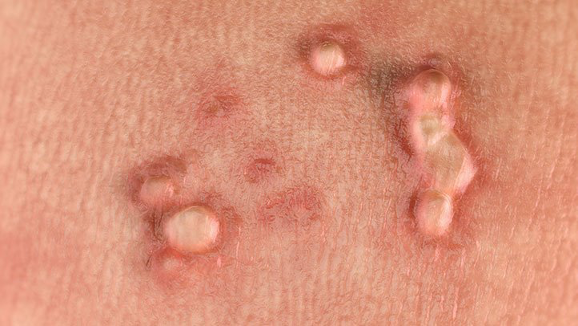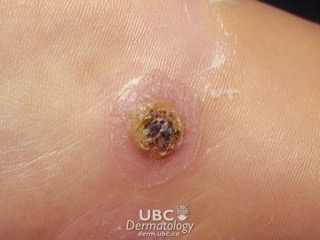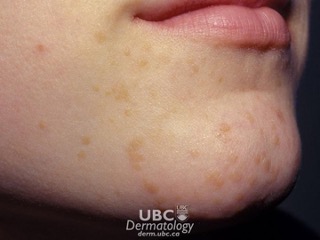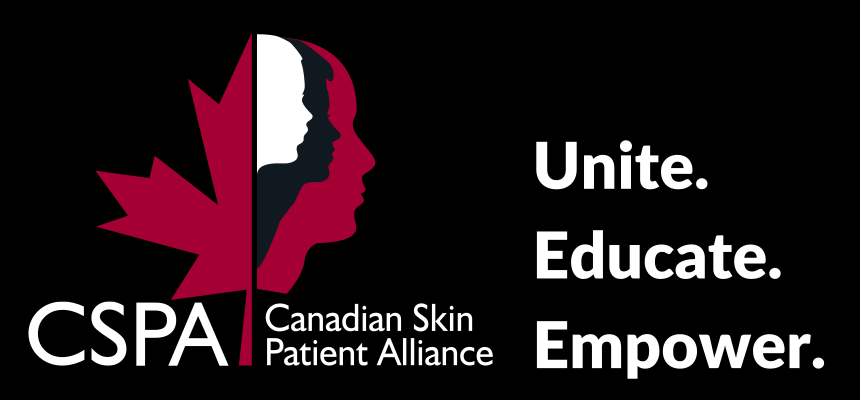Resources
If you are living with warts or know someone who is, you may want to stay up-to-date on the condition as well as current treatments and news.
Other Resources
coming soon
If you are living with warts or know someone who is, you may want to stay up-to-date on the condition as well as current treatments and news.
coming soon
Only a physician can confirm whether or not you have warts, so if you experience any wart-related signs or symptoms, visit your doctor. Some skin growths that may resemble warts are actually moles, corns, calluses, skin tags, or even skin cancer. It is particularly important to seek help if you suspect that you have genital warts because they are sometimes linked to the development of cancer. More information relating to genital warts related to cancer can be found here.
Your physician will perform a physical examination that consists of a visual inspection, sometimes with a special magnifying instrument called a dermatoscope. Occasionally, a biopsy of the lesion will be performed if the physician is uncertain of the diagnosis. It is recommended that individuals with anogenital warts be screened for other sexually transmitted infections (STIs), and women should be referred for gynecologic screening. Women with genital warts may undergo a Pap test to make sure they have no signs of cervical cancer as these are often asymptomatic in early stages.
Although warts can sometimes disappear without treatment, many people choose to treat their warts if they are unsightly, start to spread, or cause discomfort. Talk to your doctor about whether treatment is appropriate and which treatment may be right for you.
If you develop warts, you can make several lifestyle changes to help them heal properly and prevent them from spreading:
|
AVOID |
INSTEAD |
|
|
You can change your lifestyle to prevent the spread of genital warts once they occur:
|
AVOID |
INSTEAD |
|
|
Most wart treatments are topical. Some treatments can be carried out at home, and some must be applied by a doctor. They each use a different chemical to achieve the same thing; to kill the wart cells, causing them to peel and fall off. Treatments are also available to help your body’s immune system attack the wart cells. The type of wart treatment you will use depends on what type of warts you have. If you are currently using steroids, have a condition that impairs your circulation or puts you at risk for neuropathies (such as diabetes); check with a doctor before initiating any of these treatments.
Cantharidin and cantharidin combination products cause skin to blister and peel off. They are used by doctors for the treatment of warts and molluscum.2 They work by causing the formation of blisters within 24 to 48 hours and healing usually occurs within 4 to 7 days of application.2 Complications are rare when cantharidin is used appropriately, though there may be mild to moderate pain, temporary redness, a temporary burning sensation or itchiness of the skin with application. These products are available alone and in combination with other wart-removing agents such as salicylic acid and podophyllin.
Imiquimod is a prescription immune-response modifier that causes your body’s normal immune defences to work against the wart. It is provided as a prescription cream and can be used to treat external genital warts (i.e., warts on the penis or the vulva), and warts near the anus. It is also used for other kinds of skin conditions such as cancerous and pre-cancerous skin growths. For genital and perianal warts, imiquimod is usually applied at bedtime and used three times per week for up to 16 weeks, while other formulations of it are applied every night until clear. You should not apply a bandage over the cream, but you may apply a cotton gauze pad to the area. Some people experience long-term changes in skin colour such as lightening or darkening, in the treated area. If you experience serious irritation following treatment, you can discontinue imiquimod for a few days and then resume treatment when the reaction subsides. Most people experience some inflammation, reddening and irritation in the treated area. Uncommonly, some women have difficulty urinating as a result of the inflammation or develop a flu-like reaction (including fever, tiredness, muscle aches).
Liquid nitrogen (cryotherapy) is one of the most common treatments for warts. Liquid nitrogen at very low temperatures is used to “freeze off” or “freeze burn” the wart, causing the cells in the wart to die and the wart to peel off. Liquid nitrogen is extremely dangerous to handle, and therefore it must only be applied by a doctor. You may require regular repeated treatments to remove the wart completely, and occasionally treatment may cause some scarring after the wart is removed.
Podophyllin and podofilox (podophyllotoxin) cause skin cells, including the wart cells, to die and then peel off. These preparations are used by doctors to remove external genital warts, common warts and plantar warts. Podophyllin is available alone and in combination with other wart-removing agents (salicylic acid and cantharidin). Your doctor will apply the first dose of podophyllin and will instruct you on how to apply the later doses, usually once or twice a day for up to three days, followed by at least four days of no treatment. On the advice of your doctor, you may repeat this course of treatment (three days of treatment followed by four days of no treatment) for up to four weeks. When using podophyllin, apply it directly to the warts, using a layer of petroleum jelly to protect the surrounding skin. It will dry to form a film surrounding the wart. You should not use podophyllin if you are pregnant.
Salicylic acid is one of several strong acids used to “burn off” warts. In general, removal of the external thick dead skin (keratin layer) will improve the efficacy of medical therapies applied to the skin. To use, first soak the affected area in warm water for five minutes and remove softened wart tissue with a washcloth or emery board. Apply the gel directly to the wart and allow it to dry and form a barrier around the wart. Treat once a day until the wart is cleared; if you develop any discomfort, take a break from treatment, and then restart as needed. This product and other strong acids must not be used near the eyes or mucous membranes. In addition, salicylic acid is flammable and should be kept tightly capped and away from heat sources or open flames.
Other strong acids (bichloroacetic acid/trichloroacetic acid) can be used to spot-treat warts. Bichloroacetic acid and trichloroacetic acid are used for several kinds of warts, including genital and plantar warts. To avoid the risk of any damage to your skin, these treatments must be applied by your doctor. You may require repeated treatments to remove the wart completely.
Some medications that are officially approved for treating other conditions and diseases have been tried in the treatment of warts with variable success. Some alternative treatments and home remedies have also been studied in the treatment of warts, but the evidence is either mixed or limited. These treatments are included here for information only.
Footnotes:
Non-genital warts don’t usually have a major impact on patients’ health though large or multiple warts may be unsightly and may affect quality of life. Aside from the pain caused by plantar warts, non-genital warts pose no risk or discomfort to otherwise healthy individuals. However, seeking medical treatment for warts may resolve any discomfort and improve the cosmesis of the skin.
Management of genital warts involves the modification of sexual habits to prevent the spread to sexual partners. Ensuring safe sexual practices will reduce the risk of transmission to others. Preventing the development of genital warts through vaccination against HPV will also reduce the risk of genital warts that can lead to cancer. More information on the prevention of HPV can be found in the section on HPV. If you are having trouble coping with your condition, it is important to see additional support through your physician, or other mental health supports as appropriate.
The CPSA gratefully acknowledges Jessica Ho, MSc Public Health, MD candidate, Queen’s University, and Yuka Asai, MD, PhD for assistance in the preparation of this report. August 2021.
Warts are small growths on the skin caused by the human papillomavirus (HPV). This virus invades skin cells and enters a resting period, called latency, that may last for months or years. During latency, the virus multiplies and invades additional cells, which then take on the appearance of warts. Over 200 strains of HPV have been identified from DNA sequence data,1 more information on HPV can be found here (link to HPV section). Certain strains tend to infect specific areas of the skin and there are six primary types of warts.
Primary types of warts:
Warts are contagious and can spread through direct and indirect contact. This includes direct spread via skin to skin contact as well as indirectly from surfaces (fomites). All warts are more likely to spread by trauma to the skin which may occur through nail-biting, picking of the wart, rubbing (such as via callouses) and activities like shaving. Genital warts may be spread through skin to skin contact that occurs with sexual activity. Fomites are objects or surfaces that can spread infections like HPV. Spread via fomites may occur on contact with surfaces such as shower stall floors, swimming pool decks and improperly cleaned instruments that have been in contact with an HPV infection. Oral warts may also occur and can be seen in uncommon conditions such as focal epithelial hyperplasia (Heck’s disease).
Some people may have a predisposition to HPV infection and the development of warts. Often these are people who have immunodeficiencies where the body is more susceptible to infections such as HPV. While these are rare, immunodeficiencies include conditions like epidermodysplasia verruciformis (EDV).
Although warts frequently recur after treatment, many will disappear spontaneously within two to three years. Some strains of HPV that cause genital warts have the potential to cause cancer of the cervix, vulva, penis and anus. More information about the development of cancer related to HPV infections can be found in the HPV section (link to HPV section).
Non-genital warts:
Genital warts:
The symptoms of warts vary depending on their location on the body.




Charitable Number: 80425 7814 RR 0001
